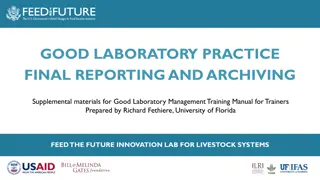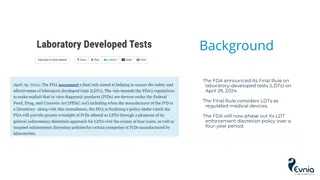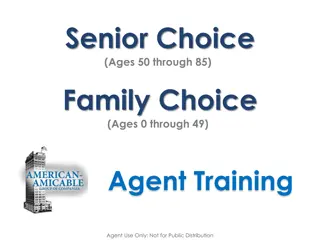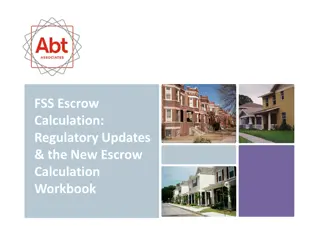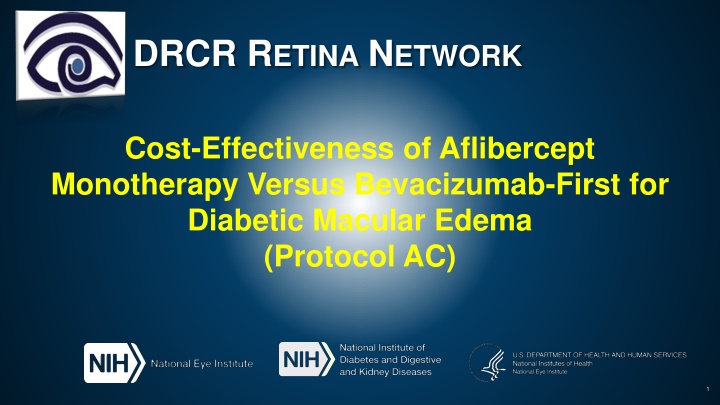
Cost-Effectiveness of Aflibercept Monotherapy vs. Bevacizumab-First for Diabetic Macular Edema
A study by DRCR RETINA NETWORK compared the cost-effectiveness of aflibercept monotherapy and bevacizumab-first followed by aflibercept for treating diabetic macular edema (DME). Results showed no significant visual acuity differences over two years in eyes with starting visual acuity 20/50 or worse. The analysis included costs of clinic visits, injections, and anti-VEGF agents, measuring in 2022 dollars and discounting by 3% in year 2. The incremental cost-effectiveness ratio (ICER) was calculated to determine the economic implications of the two treatment strategies.
Download Presentation

Please find below an Image/Link to download the presentation.
The content on the website is provided AS IS for your information and personal use only. It may not be sold, licensed, or shared on other websites without obtaining consent from the author. If you encounter any issues during the download, it is possible that the publisher has removed the file from their server.
You are allowed to download the files provided on this website for personal or commercial use, subject to the condition that they are used lawfully. All files are the property of their respective owners.
The content on the website is provided AS IS for your information and personal use only. It may not be sold, licensed, or shared on other websites without obtaining consent from the author.
E N D
Presentation Transcript
DRCR RETINA NETWORK Cost-Effectiveness of Aflibercept Monotherapy Versus Bevacizumab-First for Diabetic Macular Edema (Protocol AC) 1
Background 2022 CMS reimbursement rates for the dose and injection procedure: Bevacizumab costs $182.06 per injection ($67.86 for the drug) Aflibercept costs $1,945.69 per injection ($1,831.49 for the drug) Given the cost difference, some insurance companies may require DME treatment initiation with bevacizumab and switch to another anti-VEGF agent if the clinical response is not adequate. 2 CMS = Centers for Medicare & Medicaid Services
Background Until recently, it was not known whether this strategy would compromise long-term visual acuity relative to aflibercept monotherapy. Results from Protocol AC have now demonstrated that in eyes with starting visual acuity 20/50 or worse, no clinically meaningful differences in visual acuity outcomes over 2 years were identified between eyes treated with aflibercept monotherapy vs bevacizumab- first with eyes receiving aflibercept if needed. 3
Objective To evaluate the cost-effectiveness of aflibercept monotherapy vs. bevacizumab first followed by aflibercept if needed for DME. 4
Methods Costs Included clinic visit, OCT, injection, and anti-VEGF agent costs. Measured in 2022 dollars and discounted 3% in year 2. Health Utility: Quality Adjust Life Years (QALYs) Primary: VA in the participant s better-seeing eye at each visit were converted to QALYs using Brown method1 Sensitivity: VA in the participant s study eye at each visit were converted to QALYs using RESTORE method2 1 Brown MM, Brown GC, Sharma S, Landy J. Health care economic analyses and value-based medicine. Surv Ophthalmol. 2003;48(2):141-143. 2 Mitchell P, Annemans L, Gallagher M, et al. Cost-effectiveness of ranibizumab in treatment of diabetic macular oedema (DME) causing visual impairment: evidence from the RESTORE trial. Br J Ophthalmol. 2012;96(5):688-693 5
Methods Cost-effectiveness The incremental cost-effectiveness ratio (ICER) was calculated by taking the incremental cost of the two treatments dividing by the incremental QALYs gained. Analyses Only participants with 1 study eye were included in the analyses (84.4% of participants) 6
DRCR RETINA NETWORK Results 7
Baseline Characteristics Aflibercept Monotherapy* (N = 116) 62 51% 50% 22% 25% 3% 62 (20/63) 474 Bevacizumab First* (N = 112) 61 51% 53% 17% 28% 3% 60 (20/63) 485 Age (y), median Female White Black/African American Hispanic or Latino Other VA letter score, median (Snellen Equivalent) Race/Ethnicity OCT CST ( m), median (Spectralis) VA = Visual acuity; OCT = optical coherence tomography; CST = Central subfield thickness 8 * Limited to unilateral patients (i.e., patients with one study eye); CST not available for one participant in the aflibercept monotherapy group.
Study Visits and Treatments Aflibercept Monotherapy* (N = 116) Bevacizumab First* (N = 112) No. of visits completed up to 2 years, mean No. of injections up to 2 years, mean Bevacizumab 19.9 20.4 13.0 14.7 -- 9.0 13.0 Aflibercept 5.7 % switched to aflibercept -- 62.5% 9 * Limited to unilateral patients (i.e., patients with one study eye)
Visual Acuity Aflibercept Monotherapy Bevacizumab First Baseline VA Study eye, mean (letter score) Better-seeing eye, mean (letter score) % study eye as the better-seeing eye 2-Year VA Study eye, mean (letter score) Better-seeing eye, mean (letter score) % study eye as the better-seeing eye 58.8 76.0 12.1% 57.2 74.8 12.5% 72.4 80.5 36.2% 72.7 79.9 41.1% 10
Utility Over Time (Better-Seeing Eye Utility Mapping) 1 0.9 0.8 0.9 0.7 0.88 0.6 Utility 0.5 0.86 0.4 0.3 0.84 0.2 0.82 0.1 0 52 104 0 0 4 8 12 16 20 24 28 32 36 40 44 48 52 56 60 64 68 72 76 80 84 88 92 96100104 Visit, Weeks 11
Utility Over Time (Study Eye Utility Mapping) 1 0.9 0.8 0.84 0.7 0.6 Utility 0.82 0.5 0.4 0.8 0.3 0.2 0.78 0.1 0 52 104 0 0 4 8 12 16 20 24 28 32 36 40 44 48 52 56 60 64 68 72 76 80 84 88 92 96100104 Visit, Weeks 12
Cost-Effectiveness (Better-Seeing Eye Utility Mapping) Aflibercept Monotherapy Bevacizumab First Incremental Cost per participant over 2 years*, mean QALYs over 2 years, mean Incremental cost- effectiveness ratio $26,504 $13,929 $12,575 1.719 1.704 0.015 -- -- $837,077 13 * Accounting for the number and types of anti-VEGF treatments and number of visits
Cost-Effectiveness (Study Eye Utility Mapping) Aflibercept Monotherapy Bevacizumab First Incremental Cost per participant over 2 years*, mean QALYs over 2 years, mean Incremental cost- effectiveness ratio $26,504 $13,929 $12,575 1.627 1.615 0.012 -- -- $1,090,496 14 * Accounting for the number and types of anti-VEGF treatments and number of visits
Tornado Diagram of One-Way Sensitivity Analysis (Better-Seeing Eye Utility Mapping) Incremental Cost-Effectiveness Ratio Millions $0.0 $0.5 $1.0 $1.5 $2.0 Low High Value (0.87-0.97) (0.74-0.86) (0.79-0.89) ($1373.62-$2289.37) (0.57-0.77) (0.70-0.84) (0.55-0.77) (0.67-0.81) ($50.9-$84.83) (0-7%) ($85.65-$142.75) ($69.04-$115.07) (0.82-0.92) ($30.89-$51.48) Utility with 20/20 Utility with 20/40 Utility with 20/30 Cost of Aflibercept (2mg) Utility with 20/100 Utility with 20/50 Utility with 20/200 Utility with 20/70 Cost of Bevacizumab Discount Rate Cost of Injection Procedure Cost of Visit Utility with 20/25 Cost of OCT Low High 15
Sensitivity to Cost of Treatment per Dose (Better-Seeing Eye Utility Mapping) $1,000,000 ICER of Aflibercept vs. Bevacizumab $800,000 $600,000 First $400,000 $305 $200,000 $0 $0 $200 $400 $600 $800 $1,000 $1,200 $1,400 Drug Cost $100,000 per QALY threshold Cost of Aflibercept 16 * Visual acuity of the better-seeing eye were mapped to QALYs.
Sensitivity to Cost of Treatment per Dose (Better-Seeing Eye Utility Mapping) $1,000,000 ICER of Aflibercept vs. Bevacizumab $800,000 $600,000 First $400,000 $305 $1,307 $200,000 $0 $0 $200 $400 $600 $800 $1,000 $1,200 $1,400 Drug Cost Cost of Aflibercept Cost of Bevacizumab $100,000 per QALY threshold 17 * Visual acuity of the better-seeing eye were mapped to QALYs.
Cost-Effectiveness Acceptability Curves (Better-Seeing Eye Utility Mapping) 1 Probability Treatment is Cost- 0.8 0.6 Effective 0.4 0.2 0 $0 $200,000 $400,000 Willingness-to-Pay $/QALY $600,000 $800,000 $1,000,000 18 * Visual acuity of the better-seeing eye were mapped to QALYs.
Cost-Effectiveness Acceptability Curves (Better-Seeing Eye Utility Mapping) 1 Probability Treatment is Cost- 0.8 0.6 Effective 0.4 0.2 0 $0 $200,000 $400,000 Willingness-to-Pay $/QALY $600,000 $800,000 $1,000,000 19 * Visual acuity of the better-seeing eye were mapped to QALYs.
Summary This cost-effectiveness analysis shows that aflibercept monotherapy treatment approach is not cost-effective compared with a bevacizumab- first approach for eyes with moderate to severe vision loss from center- involved DME. The health-related quality-of-life gains that favored aflibercept monotherapy in the first year were small and not statistically significant. The increased costs were substantial at > $12,500 per participant over 2 years. Aflibercept could be cost-effective to have an ICER of $100,000 per QALY, if the price per dose were $305, or conversely, if the price of bevacizumab per dose were $1,307. 20
Limitations The results are based on a single trial Cost differences are large, and the visual outcomes were very similar appear robust. findings Costs were based on Medicare reimbursement values. The costs of individual medications might vary with substantially lower negotiated rates for aflibercept. This study is based on two years of outcomes. Potential longer-term impacts are not examined. The switching criteria used are just one approach developed by consensus of DRCR Network investigators. Results only apply to the anti-VEGF agents evaluated in this trial. 21
Conclusions Variability in individual needs will influence clinician and patient decisions about how to treat specific eyes with center-involved DME. The bevacizumab-first approach as used in this study may confer substantial cost savings on a societal level without sacrificing visual acuity gains over 2 years compared with aflibercept monotherapy for treatment of center-involved DME. 22

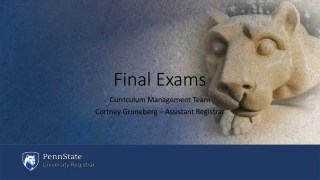
![READ⚡[PDF]✔ Yup I'm Dead...Now What? The Deluxe Edition: A Guide to My Life Info](/thumb/20463/read-pdf-yup-i-m-dead-now-what-the-deluxe-edition-a-guide-to-my-life-info.jpg)



